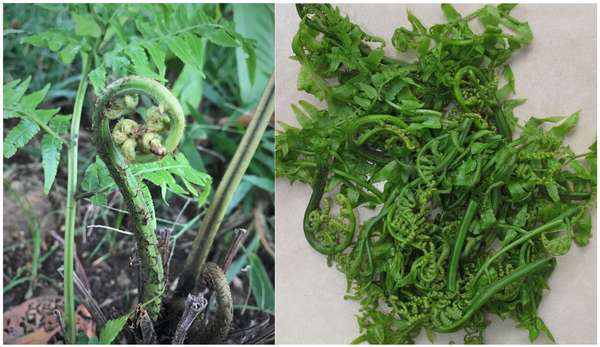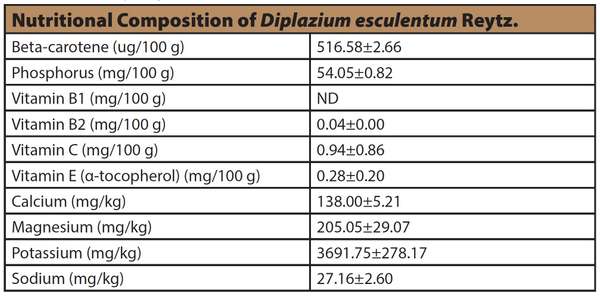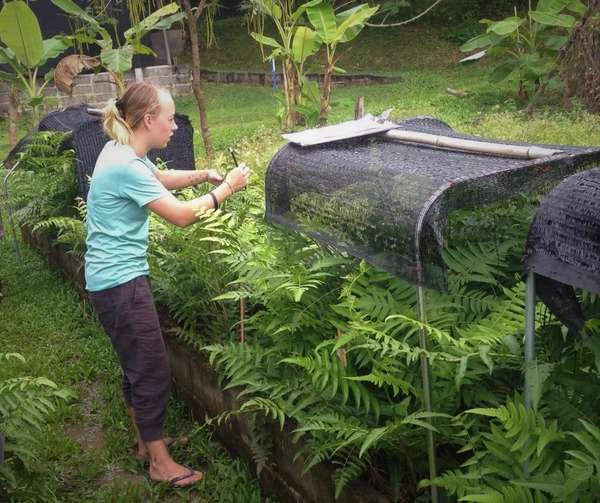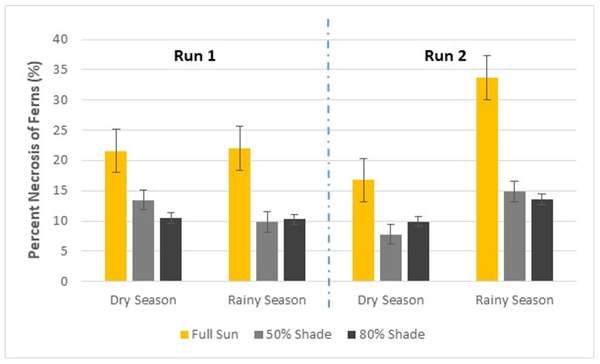1Patrick Trail, 1Yuwadee Danmalidoi , 1,2Abram Bicksler, and 1,3Rick Burnette
1ECHO Asia Impact Center, Chiang Mai, Thailand
Current Affiliations:
2Food & Agriculture Organization, United Nations, Rome, Italy
3Cultivate Abundance, Fort Myers, Florida, USA
[Editor’s Note: This topic of interest dates back a few years to when Rick Burnette served as Director of ECHO Asia. Observing that local edible vegetable ferns were only being wild-harvested and made available at market certain times of the year, he rationalized that perhaps this local Neglected and Underutilized Species could be cultivated on-farm, using artificial shade, thus making it marketable in the ‘off-season’ as well. Since that time, the experiment has been replicated and wrapped up (with the help of many hands), and the following article summarizes what we have learned.]

Introduction to Vegetable Fern
Several species of edible ferns exist around the world, ranging from the tropics to more temperate regions, and most commonly include the bracken ferns (Pteridium spp.), ostrich fern (Matteuccia struthiopteris), and the Stenochlaena spp. ferns. However, the focus of this study is on the vegetable fern (Diplazium esculentum Reytz.), a tropical perennial vegetable crop typically found growing in the Asia and Oceania regions. Sakai et.al. (2016) categorize this edible vegetable fern as a Non-Timber Forest Product or NTFP. It is a regionally significant vegetable crop in India, Bangladesh, Thailand, Malaysia, Philippines, and the US state of Hawaii (Lin et al., 2009). The young tender fronds of the fern (commonly referred to as ‘fiddleheads’) are typically eaten fresh, boiled, blanched, or cooked in curries, depending on the region in which they are consumed (Duncan, 2012).
Nutritional analysis of vegetable fern indicates several positive nutritional properties, being rich in beta-carotene, folic acid, along with calcium, iron, and phosphorus minerals; while anti-nutritional properties such as phytic acids, tannins, and trypsin are present in non-toxic amounts (Archana et al., 2012; Junejo et al., 2015). Results of nutritional analysis of Diplazium esculentum undertaken at Kasetsart University in Bangkok shows a rich nutritional composition (Table 1).

Vegetable fern can be found seasonally in many Asian markets and are typically wild harvested from moist, shaded areas alongside riverbanks and within wooded areas. During the rainy season, bundles of vegetable fern are commonly observed in local markets in these
regions but do not appear to be supplied in sufficient quantities to satisfy consumer demand during the dry months when market availability all but disappears.
To date, minimal research has been undertaken on the cultivation potential of vegetable fern, and its potential agronomic opportunities and limitations. Vegetable fern continues to be supplied to market in large part by wild harvested means but has yet to become widely cultivated as a managed crop species. Mertz (1999) compared the cultivation potential of Stenochlaena palustris (Burm.) and Diplazium esculentum (Retz.) in Malaysia and found the cultivation of the latter to be unfeasible in unshaded growing conditions. Recent work at the ECHO Asia Regional Impact Center in northern Thailand indicates that it can be grown and may even thrive in a managed shaded production system.
Objectives of the Study
Growing vegetable fern beyond its typical seasonal availability could serve as a potential niche market for smallholder farmers seeking to enter new markets, making this experiment of potential interest to many within the ECHO network and beyond.
Growing Ferns Under Varying Levels of Shade
Location and Site Description
Field trials took place at the ECHO Asia Seed Bank during the 2011 and 2017/2018 growing seasons. Climatic conditions of the study site, located in the hills of northern Thailand (20° 1’N, 99° 17’E), are characterized by a distinct rainy season (May to October) and a distinct dry season (November to April) with temperatures typically ranging between 25oC and 30oC throughout the year (Table 2).
Ferns were grown in full sun locations in raised beds under three different shade treatments:
1) no shade (0%) control, 2) low shade (50%), and 3) high shade (80%). The experiment was arranged as a Randomized Complete Block Design (RCBD) with four replications. Individual open-ended row covers of shade cloth were suspended 1.5m above raised beds depending on the treatment (Figure 2), and a system of micro sprinklers were put in place for irrigation purposes during the dry season months to mimic a moist condition similar to the local environment where it typically grows. Harvest intervals for both runs of the experiment spanned a 1 year period, allowing for the comparison of growth and yields according to season, wet or dry.

Experimental plots were 1m by 1m and fern propagules were transplanted at approximately 30 cm by 30 cm planting density, for a total of 9 plants per plot. Propagules were dug from an established bed of growing ferns which had previously been wild harvested locally and transplanted.
Ferns were transplanted into raised beds that previously received several years of organic soil amendments, including compost, cow manure, and rice straw mulch. For this experiment, no additional soil amendments were added to the soil during the trial period. However, beds were mulched prior to each planting season with a generous layer of rice straw mulch at approximately 4 tonnes per hectare, proving to be an important step in retaining soil moisture and ensuring weed suppression during fern establishment.
Data Collection
Once transplants were established (3 months after transplanting), harvest data of marketable fern fronds (fiddleheads) were collected every 3 weeks from the middle row of each plot, the sampling area. Fern growth data were continuously collected in 3-week intervals over one year, for a total of 14 sampling periods. Fronds were counted and weighed wet, while subsamples were oven-dried to calculate dry weight. Both plant height and percent necrosis (plant death) data were measured every 3 weeks in the sampling area of each plot. Plant height was calculated using the tallest outstretched fern leaf, while percent necrosis or death of plants was estimated using a visual ranking score of 0 (no necrosis/death) to 100 (complete necrosis/death), outlined by Deadman et al. (2002).
At various points during the experiment, visits were made to the local market to purchase edible vegetable fern, in an attempt to monitor availability and market price depending on the time of the year. Fronds (fiddleheads) were purchased by the bundle and fresh weights were recorded, as were the number of individual fronds included. Market-bought ferns were acquired from a local rural market in the nearest town (Fang), and in the nearby city of Chiang Mai to evaluate differences in price.
Shade Matters, and Moisture Does Too!
Results from our field trials indicate that the cultivation of vegetable fern on farm can in fact be productive, both in the rainy and dry seasons. Production was higher during rainy season compared to dry season months, even when adequate irrigation was provided throughout the year. Our results indicate that shade does play an important role in a managed production system, with shaded plots out-performing those that were unshaded in almost every instance (Figure 3). Ferns grown under partial shade structures (50% shade) yielded more than those under higher shade (80%) in both trial runs, though differences between the two were small compared to having shade and no shade in general.

Ferns grown without shade displayed higher rates of necrosis/plant death than those that had shade, in every instance. This death in vegetative parts indicates that the vegetable fern is highly sensitive to sunlight and therefore a major factor to consider in domesticating the plant. There was 1.5oC average annual temperature difference between runs 1 and 2, which explains in part the additional growth, and subsequent necrosis without shade, in the second run compared to the first run.

In analyzing the results of this work, we noticed a large difference in the yield between the rainy seasons and the dry seasons of run 2 compared to run 1. This correlates to an extended rainy season and an above average amount of rainfall during the second run (2297mm compared to 1700mm in run 1). This seems to indicate that while shade does make a difference in yield and is a necessary factor in the production of vegetable fern, adequate moisture may be as equally important. Though irrigation was provided every 3-4 days throughout the season, it may be necessary to have more moisture throughout, with no chance for water stress.
Prospects and Small-Scale Farm Application
While these results are by no means exhaustive, they do indicate that there is significant potential for the production of vegetable fern in managed settings. We believe that the small-scale production of vegetable fern can and should be integrated into small-scale farm operations, both as a cash crop and for household consumption. This Neglected & Underutilized Species (NUS) holds potential as a marketable niche crop, as well as a nutritionally rich supplemental vegetable for household dietary diversity. There remains great potential for vegetable fern as a niche crop, both locally in Southeast Asia and beyond. Further research is necessary to refine the cultivation practices for this vegetable fern, but there is promising potential for cultivation managed production settings.
Acknowledgements
The authors would like to thank the many people that had a hand in this ongoing project. Many hands helped along the way with data collection and plot maintenance, with special thanks necessary to ECHO Asia volunteers James Manson, Karis Lotze, and Caleb & Cayleigh Philips. Thank you for your help establishing and maintaining plots, and tedious data collection.
References
Archana, G. N., Pradeesh, S., Chinmayee, M. D., Mini, I., Swapna, T. S. (2012). Diplazium esculentum: a wild nutrient-rich leafy vegetable from Western Ghats. In: Sabu, A., Agustine, A. (eds) Propsects in Bioscience: Addressing the Issues. 293-301.
Deadman, M. L., Khan, I. A., Thacker, J. R. M., Al-Habsi, K. (2002). Interaction between leafminer damage and leaf necrosis caused by alternaria alternata on potato in the Sulfanate of Oman. The Plant Pathology Journal. 18(40): 210-215.
Duncan, K., Chompoothong, N., Burnette, R. 2012. Vegetable Production Throughout the Rainy Season. ECHO Asia Notes. 13: 1-14.
Junejo, J. A., Ghoshal, A., Mondal, P., Nainwal, L., Zaman, K., Singh, K. D., Chakraborty, T. (2015). In-vivo toxicity evaluation and phytochemical, physiochemical analysis of Diplazium esculentum (Retz.) Sw. leaves a traditionally used North-Eastern Indian vegetable. Advances in Bioresearch. 6(5): 175-181.
Lin, L. J., Hsiao, Y. Y., & Kuo, C. G. (2009). Discovering Indigenous Treasures: Promising Indigenous Vegetables from Around the World. World Vegetable Center. 9(720): 118-121.
Mertz, O. (1999). Cultivation potential of two edible ferns, Diplazium esculentum and Stenochlaena palustris. Tropical Agriculture. 76(1): 10-16.
Sakai, S., Choy, Y. K., Kishimoto-Yamada, K., Takano, K. T., Ichikawa, M., Samejima, H., Kato, Y., Ushio, M., Saizen, I., Nakashizuka, T., Itioka, T. (2016). Social and ecological factors associated with the use of non-timber forest products by people in rural Borneo. Biological Conservation. 204: 340-349.
